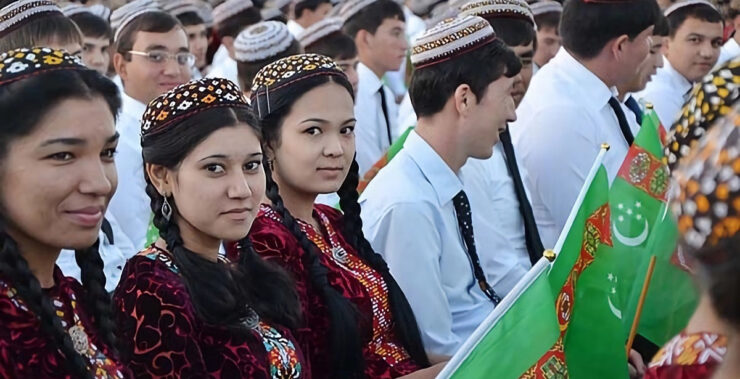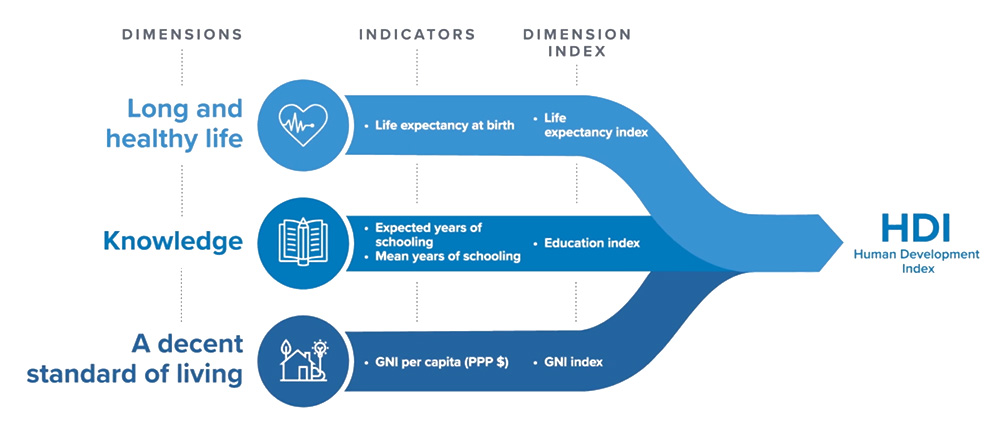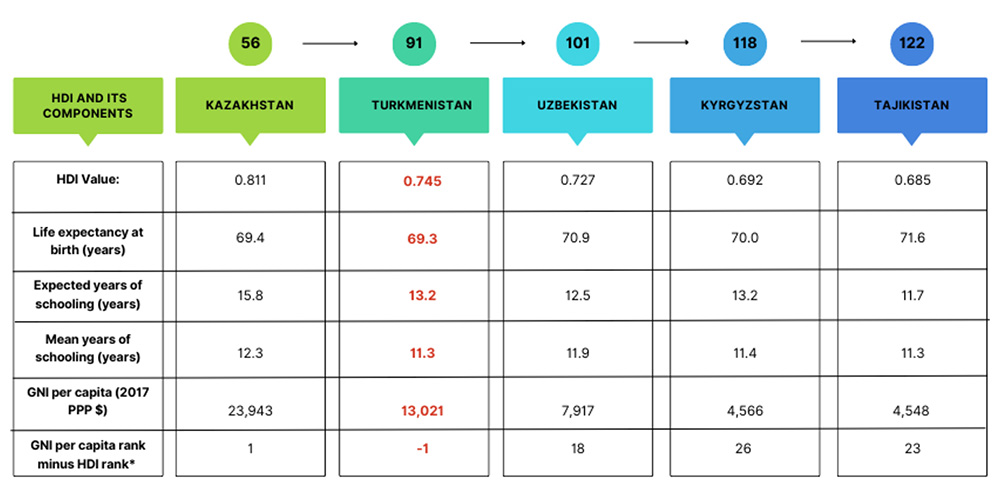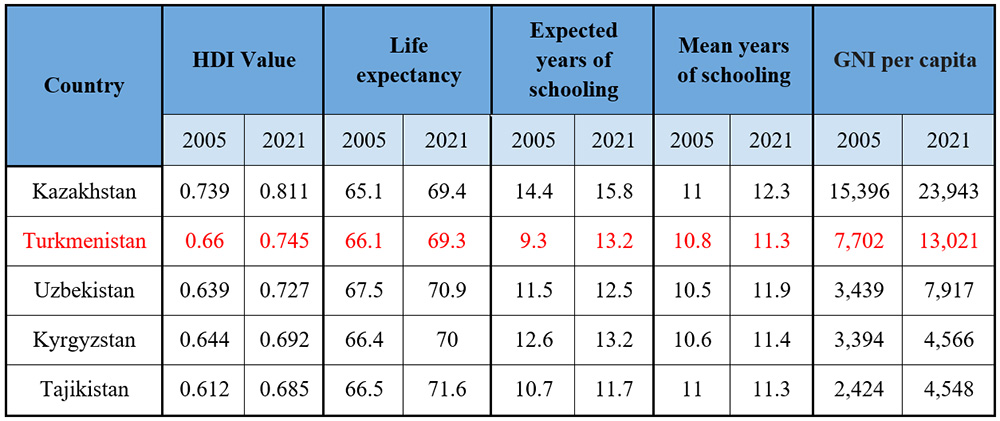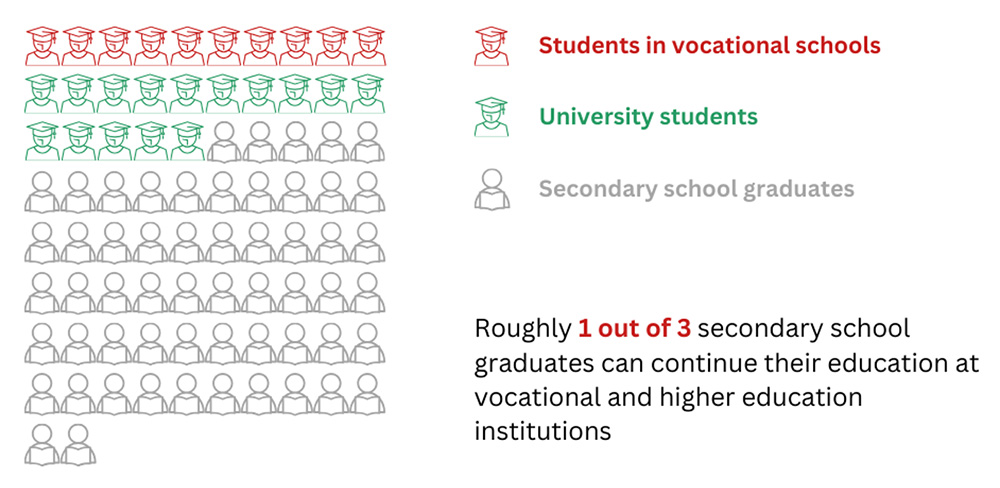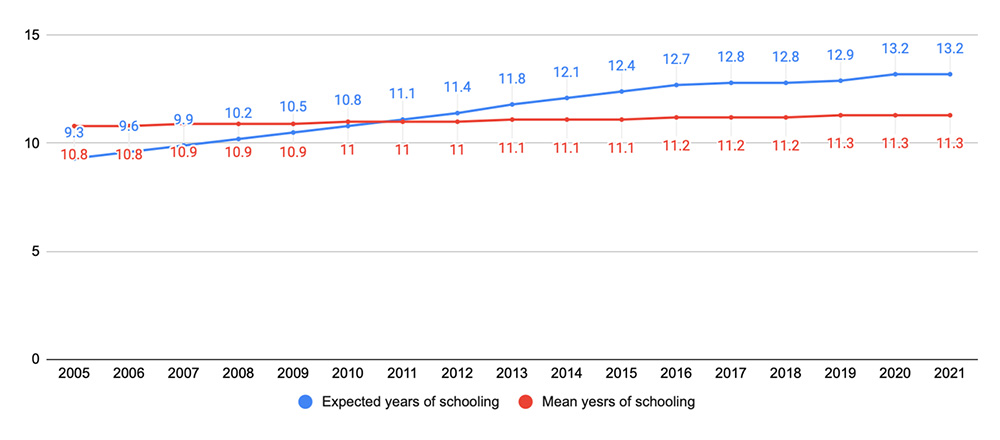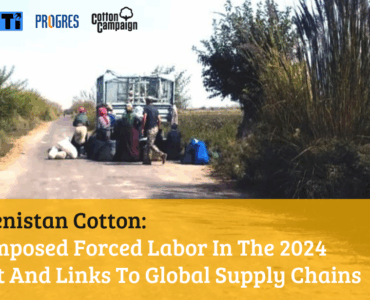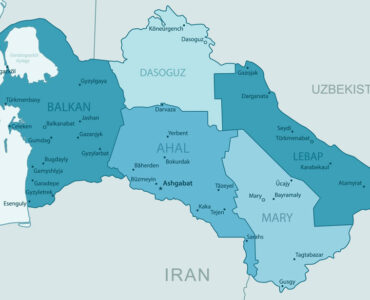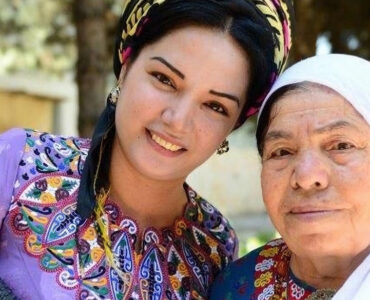Summary: Although Turkmenistan ranks ‘high’ on the Human Development Index, a closer look at the index reveals poor outcomes in health, education and standard of living. Turkmenistan has the lowest life expectancy in Central Asia. People in Turkmenistan live 2.3 years shorter than people in Tajikistan despite having almost 3 times bigger gross national income per capita. Youth in Turkmenistan have limited educational prospects as only 3 out of 10 secondary school graduates continue their education at tertiary level. It is time that the government of Turkmenistan prioritizes the development of its people, the country’s most valuable but underutilized asset.
This is the first article in a series examining human development in Turkmenistan. Our next articles focus on government spending on education and healthcare and present complementary metrics examining inequality and gender gaps in the distribution of human development.
Turkmenistan’s most valuable, yet underutilized asset is its people. Despite being rich in oil and gas, these nonrenewable resources have been poorly managed for short-term gains. According to a recent study, natural resources were initially a “resource blessing” for Central Asian resource rich countries such as Turkmenistan but later became a “resource curse” as the governments abused and mismanaged natural resource revenues. The study finds that institutional quality and human development positively influence financial growth. However, current policies in Turkmenistan neglect human development, leading to poor health, low life expectancy, inferior education, and limited opportunities, adversely affecting generations of people.
Instead, the government should adopt a human-centered development approach, focusing on the physical, social, emotional, and economic wellbeing of its citizens. By investing in and nurturing its people, Turkmenistan can achieve sustainable development and long-term progress.
This analysis is based on data and research from UNDP, UNESCO, WHO, Academia.edu, Financial Innovation, the World Happiness Report, the Index of Economic Freedom, Progres.Online, the Institute for War and Peace Reporting, and Turkmenportal.
Human Development Index
One way to examine if Turkmenistan is creating necessary opportunities for its people to grow and contribute is through measuring the level of human development in the country. UNDP defines human development as “the capability for a long and happy life, for qualitative education and participation in the economy to lead a life with dignity.” The index is a composite of three indicators such as – longevity, education, and income.
Figure 1. Human Development Index (HDI)
Source: Human Development Report.
According to the latest data from 2021, Turkmenistan’s HDI value is 0.745, which puts the country in “the high human development” category. HDI is measured on a scale from 0 to 1.0, with 1.0 representing the highest possible level of human development and 0 representing the lowest. When looking only at the final index, Turkmenistan is the second-best performer in Central Asia after Kazakhstan. However, when zooming in on each component of the index separately and comparing it against other countries, Turkmenistan is much closer to Tajikistan, the worst performer on the index. Turkmenistan ranks higher on HDI because of its high gross national income, driven by its oil and gas sector. When subtracting GNI per capita rank from HDI, Turkmenistan is the only country in Central Asia with a negative value (-1).
Figure 2. Human Development Index and its Components for Central Asia, 2021
* Difference in ranking by Gross National Income (GNI) per capita and by HDI value. A negative value means that the country is better ranked by GNI than by HDI value.
Source: Human Development Index.
Between 2005 and 2021, Turkmenistan’s HDI value changed from 0.660 to 0.745, an increase of 12.9%. However, this increase was primarily driven by the GNI per capita, which almost doubled during this timeframe, increasing from $7,702 to $13,021. Meanwhile, other components of HDI did not change as much.
It is worth mentioning that since 2016 Turkmenistan has maintained a dual exchange rate system, where the official rate was fixed at 3.5 manat/USD while the black market rate fluctuated reaching 28.90 manat per dollar in 2021. The GNI per capita in Turkmenistan is calculated in US dollars using the official exchange rate. This makes it appear higher than it would be if calculated using the black-market rate, which reflects the actual cost of goods and services for people. Consequently, the use of the lower official exchange rate inflates the GNI figures, leading to a higher HDI ranking for Turkmenistan.
How healthy are the people and how long do they live in Turkmenistan?
Turkmenistan has the lowest life expectancy in Central Asia. From 2005 to 2021 Turkmenistan experienced the smallest improvements in life expectancy in the region. The life expectancy at birth in Turkmenistan increased by 3.2 years while in Tajikistan it increased by 5.1 years. In fact, in the last 32 years, from 1990-2021, life expectancy at birth in Turkmenistan has only increased by 5.3 years while in Tajikistan it increased by 9.6 years. Although Turkmenistan’s GNI per capita is 186.3% more than that of Tajikistan, a person in Tajikistan lives, on average, 2.3 years longer than a person in Turkmenistan.
Figure 3. Comparing HDI Values and its Components for 2005 and 2021 for Central Asia
Source: Human Development Reports.
In addition to length, the quality of years lived is also important. The World Health Organization examines the ‘healthy life expectancy’, which refers to the average number of years that a person can expect to live in “full health” from birth. For example, in 2019 the life expectancy at birth in Turkmenistan was 69.7 years while the healthy life expectancy at birth was 62.1 years. This means Turkmens lose 7.6 years of their life expectancy to serious illnesses and health problems.
How much education do people in Turkmenistan receive?
People in Turkmenistan do not receive sufficient education. Country’s results on education are among the lowest in Central Asia. There are two ways to measure the level of education in the country. First, through expected years of schooling which refers to the number of years a child of school entrance age can expect to receive if the current enrollment rates persist. Expected years of schooling in Turkmenistan is 13.2 years which is along with Kyrgyzstan 2nd best in the region. In contrast the best performer in Central Asia is Kazakhstan where children can expect to receive 2.6 years more schooling than in Turkmenistan.
The second measure of the level of education is the ‘mean years of schooling’ which refers to the average number of years the population older than 25 completed in formal education. Currently people in Turkmenistan have, on average, 11.3 years of formal education, which, along with Tajikistan, is the lowest in Central Asia. In comparison in Kazakhstan adults receive, on average, one extra year of schooling than adults in Turkmenistan.
The maximum for mean years of schooling is 15 and the maximum for expected years of schooling is 18, which is equivalent to obtaining a master’s degree in most countries. Turkmenistan does relatively well in terms of secondary education, which is mandatory and free of charge for every citizen. However, the country does poorly in tertiary education, which is illustrated by minimal increase in the average years of schooling (see Figure 4) and the large difference between the ideal (18 years) and the current rate (13.2 years) of expected years of schooling. Only 3 out of 10 secondary school graduates are able to continue their education at vocational and higher education institutions in Turkmenistan.
Figure 4. Number of secondary school graduates and number of students enrolled in secondary vocational educational institutions and universities in Turkmenistan in 2022
Source: Turkmenportal and Progres.online.
Both, the expected years of schooling and mean years of schooling were positively influenced by the two education reforms implemented by the former President Gurbanguly Berdimuhamedov. First, in 2007 he increased secondary education from nine to ten years and abolished the two-year compulsory work experience required to enter vocational and higher education institutions. Second, from 2013 the secondary education transitioned to a twelve-year system. As illustrated in Figure 4, expected years of schooling steadily increased overtime surpassing the average years of schooling in 2010 and reaching a relative stability in 2020 and 2021. The mean years of schooling increased in 2007 and in 2013, following the above mentioned education reforms, and later reached a plateau in 2019-2021.
Figure 5. Expected years of schooling and mean years of schooling for Turkmenistan overtime
* Note: ‘Expected years of schooling’ – the number of years a child of school entrance age can expect to receive if the current enrollment rates persist. ‘Mean years of schooling’ – average number of years the population older than 25 completed in formal education.
Source: Human Development Reports.
Although since 2011 it became possible to recognize foreign diplomas in Turkmenistan, it still remains difficult for foreign educated Turkmens to get jobs and reintegrate in Turkmenistan. In spite of this, Turkmen students continue to choose to study abroad in substantial numbers. This is because the majority of youth are not able to access higher education in Turkmenistan due to limited quotas at universities and widespread corruption during the enrollment process. According to UNESCO there are 69,519 Turkmen nationals studying abroad. Some of these students are choosing not to return home after graduating because of widespread corruption, lack of job opportunities, limited and censored Internet, desire to avoid constant harassment by the authorities or being refused to leave Turkmenistan and travel abroad freely. This is unfortunate for Turkmenistan as the country is losing its young and talented individuals adding to the problem of acute and sustained brain drain. These professionals could positively contribute to the country’s long-term and sustainable development.
In addition to HDI, there are many other indices that can help us understand the level of human development in Turkmenistan. First is the Human Capital Index, which excludes Turkmenistan due to lack of data. However, it reveals that a child born in Central Asia will be 60% as productive when she grows up as she could be if she enjoyed complete education and full health. Given Turkmenistan’s poor performance on HDI, we can assume that human capital in Turkmenistan is at least as low as in the rest of Central Asia.
Second is the Index of Economic Freedom, which covers 12 freedoms – from property rights to financial freedom. Turkmenistan ranks 161 out of 184 countries. As the data shows, people in countries that score high on the index enjoy higher levels of financial prosperity, live longer, have better health, are more educated and better protectors of the environment. This highlights that by providing citizens with economic freedoms Turkmenistan can foster development of its people.
Third is the World Happiness Index which asks respondents to rate their own current lives on a scale of 0 – the worst possible life and 10 – the best possible life. Turkmenistan, the second worst performer in Central Asia, scores 5.47 while Kazakhstan, the best performer in the region scores 6.23. There are six factors explaining people’s level of happiness including – social support, GDP per capita, healthy life expectancy (physical and mental), freedom to make life choices, generosity and absence of corruption. This illustrates that people’s satisfaction with life depends on various aspects, most of which are the result of government’s policy choices and priorities.
Recommendations to the government of Turkmenistan
Building human capital can lead to compounding growth over time. However, the foundation of this human capital has to be laid down today by investing in and improving the quality of education, healthcare, social protection, and employment. This will ensure an increase in human development of the current generation, who in return can further improve the perspectives for generations to come. The government of Turkmenistan should develop a new philosophy of human centered development that prioritizes and ensures intellectual freedom and physical, social, and economic wellbeing of people. The government should design a reform plan spelling out specific targets, measurable goals, clear action steps and earmarking necessary funds.
In particular, the government should
- Establish a committee of Turkmen and international experts focused on comprehensive research and data collection on human development in Turkmenistan. This committee should be tasked with gathering accurate, detailed, and disaggregated statistics on various population segments, and openly acknowledging the challenges faced in human development. The findings, data, and discussions should be made publicly available, facilitating transparent and informed discussions among journalists, researchers, NGOs, and the general public, thereby enabling the formulation of well-founded policy solutions.
- Increase public spending on healthcare and education. Given the low outcomes in life expectancy and education attainment, along with poor quality of services in these sectors, the government of Turkmenistan should increase spending and investment in healthcare and education. Increased spending should be coupled with increased transparency and efficiency to ensure funds are used effectively and openly.
- Make vocational and higher education more accessible by increasing quotas at tertiary institutions, addressing widespread corruption during enrollment, allowing creation of private professional schools and universities, establishing branches of foreign universities, providing scholarships, and making it easier for Turkmen youth to study abroad and to recognize their foreign university diplomas in Turkmenistan.
- Prioritize holistic healthcare with focus on prevention. The healthcare system in Turkmenistan should care for the whole person providing for their physical, mental, emotional, and social needs because these aspects are intertwined and being unwell in one area affects the person in others. Health services should also focus on prevention where they screen, identify and address health concerns before they turn into serious health problems.
- Promote entrepreneurship and business development by addressing the dual exchange rate and creating incentives such as tax cuts, low interest rate loans, eased bureaucracy to register a business, providing initial funding to startups, incorporating entrepreneurship education into secondary and tertiary school curricula, and ensuring effective regulatory framework. Encouraging entrepreneurship can help address unemployment, irregular labor migration within the country and brain drain, while encouraging youth to innovate and create solutions to societal problems.
- Attract Turkmen diaspora educated abroad. There are many talented Turkmen nationals who are graduates of American, European, and Asian universities. The government should engage with these individuals in reforming the country by creating favorable conditions and providing them a platform to share their expertise and contribute to improved policymaking.
This is the first article in a series examining human development in Turkmenistan. Our next articles focus on government spending on education and healthcare and present complementary metrics examining inequality and gender gaps in the distribution of human development.

